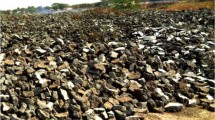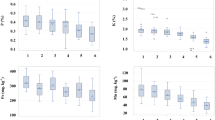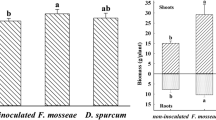Abstract
Chromium (Cr) is a nonessential element for plants that is extremely toxic at high concentrations. Zea mays L. is a species of plant that has developed adaptive mechanisms to increase its tolerance and absorption capacity for this metal. One effective mechanism is to form associations with arbuscular mycorrhizal fungi (AMF), which help the plant cope with stress from heavy metals such as Cr. However, it is still not clear which species of AMF are more efficient as bioremediating agents for plants of agricultural importance. Here, we evaluated the effect of Gigaspora gigantea and Rhizophagus irregularis as protective agents of maize plants in soils contaminated with Cr at concentrations of 0, 48.5, 97 and 194 mg kg−1 under greenhouse conditions. Maize tolerance to Cr was corroborated, as well as increased absorption of this element by plants associated with both species of AMF. G. gigantea caused an increase in nitrogen content and greater translocation of Cr to the aerial part of the plant; R. irregularis registered an increase in the formation of arbuscules and vesicles with increasing metal concentration and greater retention of Cr in the roots of the plants. Based on these results, we can conclude that the analyzed species of fungi use different strategies, with similar effectiveness, to enhance the absorption capacity of Cr by the plant and influence the differential deposition of this metal in various parts of the plant.







Similar content being viewed by others
References
Ahemad M (2015) Enhancing phytoremediation of chromium-stressed soils through plant growth-promoting bacteria. J Genetic Engin Biotechnol 13(1):51–58. https://doi.org/10.1016/j.jgeb.2015.02.001
Arias JA, Peralta-Videa JR, Ellzey JT et al (2010) Effects of Glomus deserticola inoculation on Prosopis: Enhancing chromium and lead uptake and translocation as confirmed by X-ray mapping, ICP-OES and TEM techniques. Environ Exp Bot 68:139–148
Asma BS, Ashfaq D (2013) Role of mycorrhiza to reduce heavy metal stress. Nat Sci 5(12A):16–20. https://doi.org/10.4236/ns.2013.512A003
Audet P (2014) Arbuscular Mycorrhizal Fungi and Metal Phytoremediation: Ecophysiological Complementarity in Relation to Environmental Stress. In: Ahmad P, Rasool S (eds) Emerging Technologies and Management of Crop Stress Tolerance Volume II A Sustainable approach. Elsevier-Academic Press, United State of America, pp 133–160
Bartolome-Esteban E, Schenck NC (1994) Spore germination and hyphal growth of arbuscular mycorrhizal fungi in relation to soil aluminum saturation. Mycologia 86:217–226
Cabral L, Siqueira JO, Soares CRFS, Pinto JEB (2010) Retention of heavy metals by arbuscular mycorrhizal fungi mycelium. Quim Nova 33:25–29
Cabral L, Fonseca S, Giachini A (2015) Arbuscular mycorrhizal fungi in phytoremediation of contaminated areas by trace elements: mechanisms and major benefits of their applications. Microbiol. Biotechnol, World J. https://doi.org/10.1007/s11274-015-1918-y
Cobett C, Goldsbrough P (2000) Phytochelatins and matallothioneins: roles in heavy metal detoxification and homeostasis. Plant Biol 53:159–182
Debiane D, Garcon G, Verdin A, Fontaine J et al (2008) In vitro evaluation of the oxida- tive stress and genotoxic potenitials of anthracene on my- corrhizal Chicory roots. Environ Exp Bot 64:120–127. https://doi.org/10.1016/j.envexpbot.2008.04.003
Ferrol N, Tamayo E, Vargas P (2016) The heavy metal paradox in arbuscular mycorrhizas: from mechanisms to biotechnological applications. J Exp Bot 67(22):6253–6265
Gamalero E, Berta G, Massa N, Glick BR, Lingua G (2008) Synergistic interactions between the ACC deaminase producing bacterium Pseudomonas putida UW4 and the AM fungus Gigaspora rosea positively affect cucumber plant growth. FEMS Micro- Biology Ecology 64:459–467
Gamalero E, Berta G, Glick BR (2009) The use of microorganisms to facilitate the growth of plants in saline soils. In: Khan MS, Zaidi A, Musarrat J (eds) Microbial strategies for crop improvement. Springer, Berlin, pp 1–22
García-Hernandez MA, Villarreal-Chiu JF, Garza-Gonza lez MT, (2017) Metal- lophilic fungi research: an alternative for its use in the bioremediation of hexavalent chromium. Int J Environ Sci Technol 14:2023e2038
Garg N, Sing S, Kashyap L (2017) Arbuscular mycorrhizal fungi and heavy metal tolerance in plants: an insight into physiological and molecular mechanisms. In: A. Varma et al. (eds), Mycorrhiza - Nutrient Uptake, Biocontrol, Ecorestoration, Chapter 4: 75–97. https://doi.org/10.1007/978-3-319-68867-1_4.
Gaur A, Adholeya A (2004) Prospects of arbuscular mycorrhizal fungi in phytoremediation of heavy metal contaminated soils. Current Sci 86:528–534
Gerdemann JW (1963) Spores of mycorrhizal Endogone species extracted from soil by wet sieving and decanting. Trans Brit Mycol Soc 46:235–244
Gil-Cardeza ML, Calonne-Salmon M, Gomez E, Declerck S (2017) Short-term chromium (VI) exposure increases phosphorus uptake by the extraradical mycelium of the arbuscular mycorrhizal fungus Rhizophagus irregularis MUCL 41833. Chemosphere 187:27–34
Gil-Cardeza M, Declerck S, Calonne-Salmon M (2021) Impact of increasing chromium (VI) concentrations on growth, phosphorus and chromium uptake of maize plants associated to the mycorrhizal fungus Rhizophagus irregularis MUCL 41833. Helyon 7:05891
Giovannetti M, Mosse B (1980) An evaluation of techniques for measuring vesicular arbuscular mycorrhizal infection in roots. New Phytol 84:489–500
Griffioen WAJ and Ernst WHO (1989) The role of VA mycorrhiza in the heavy metal tolerance of Agrostis capillaries L. Agriculture Ecosystem Environment 29:173–177. https://doi.org/10.1016/0167-8809(90)90272-F
González-Alejandre M, González-Cortés J, Carreón-Abud Y, Martínez-Trujillo M (2018) Total Chromium Captured by Maize (Zea mays) Plants is Increased by Phosphate and Iron Supplementation in the Soil. Commun Soil Sci Plant Anal 1532–2416:1–10. https://doi.org/10.1080/00103624.2018.1432638
González-Chávez MCA, Ortega-Larrocea MP, Carrillo-González R et al (2011) Arsenate induces the expression of fungal genes involved in As transport in arbuscular mycorrhiza. Fungal Biol 115:1197–1209
González-Guerrero M, Benabdellah K, Ferrol N, Azcón-Aguilar C (2009) Mechanisms underlying heavy metal tolerance in arbuscular mycorrhizas. In: Azcón-Aguilar C, Barea JM, Gianinazzi S, Gianinazzi-Pearson V (eds) Mycorrhizas: Functional Processes and Ecological Impact. Springer, Berlin, pp 1–16
Guo W, Zhao R, Zhao W, Fu R, Guo J, Zhang J (2013) Effects of arbuscular mycorrhizal fungi on maize (Zea mays L.) and sorghum (Sorghum bicolor L. Moench) grown in rare earth elements of mine tailings. Appl Soil Ecol 72:85–92
Hildebrandt U, Regvar M, Bothe H (2007) Arbuscular mycorrhiza and heavy metal tolerance. Phytochemistry 68:139–146. https://doi.org/10.1016/j.phytochem.2006.09.023
Jones MD, Hutchinson TC (1988) Nickel toxicity in mycorrhizal birch seedlings infected with Lactarius rufus or Scleroderma flavidum. 2. Uptake of nickel, calcium, magnesium, phosphorus and iron. New Phytol 108:461–470. https://doi.org/10.1111/j.1469-8137.1988.tb04187.x
Joner EJ, Briones R (2000) Metal-binding capacity of arbuscular mycorrhizal mycelium. Plant Soil 226:227–234
Jung SC, Martinez-Medina A, Lopez-Raez JA, Pozo MJ (2012) Mycorrhiza-induced resistance and priming of plant defenses. J Chem Ecol 38:651–664
Kaldorf M, Kuhn AJ, Schroder WH, Hildebrandt U, Bothe H (1999) Selective element deposits in maize colonized by a heavy metal tolerance conferring arbuscu- lar mycorrhizal fungus. J Plant Physiol 154:718–728. https://doi.org/10.1016/S0176-1617(99)80250-8
Kamal S, Prasad R, Varma A (2010) Soil microbial diversity in relation to heavy metals. In: Sherameti I. and Varma A. (eds), Heavy metals contamination of soils. Soil biology, Vol. 19. Chapter 3. Spinger. p. 31–63. http://dx.doi.org/https://doi.org/10.1007/978-3-642-02436-8_3
Komal T, Mustafa M, Ali Z, Kazi A (2015) Heavy metals uptake and transport in plants. In: Sherameti I. and Varma A. (eds), Heavy metals contamination of soils. Soil biology, Vol. 44. Chapter 10. Springer. p181- 194. Doi: https://doi.org/10.1007/978-3-319-14526-6_10.
Krishnamoorthy R, Kim C, Subramanian P, Kim K, Selvakumar G, Sa T (2015) Arbuscular mycorrhizal fungi community structure, abundance and species richness changes in soil by different levels of heavy metal and metalloid concentration. PLoS ONE 10(6):e128784
Lapham C, González-Hernández G, Torres-Guzán J, Ramírez-Zuñiga M (2016) Tolerancia a cromo de plantas que interaccionan con hongos micorrízicos sobrevivencia de Arabidopsis thaliana y Sorghum vulgare. Jovenes En La Ciencia 2(1):1546–1550
Leung HM, Ye ZH, Wong MH (2007) Survival strategies of plants associated with arbuscular mycorrhizal fungi on toxic mine tailings. Chemosphere 66:905–915. https://doi.org/10.1016/j.chemosphere.2006.06.037
Liu M, Jian S, Yang L, Yan X (2017) Nitrogen fertilizer enhances growth and nutrient uptake of Medicago sativa inoculated with Glomus tortuosum grown in Cd contaminated acidic soil. Chemosphere 167:204–211. https://doi.org/10.1016/j.chemosphere.2016.09.145
López-Bucio J, Cruz-Ramírez A, y Herrera-Estrella L, (2003) The role of nutrient availability in regulating root architecture. Curr Opin Plant Biol 6:280–287
Losada BLC, Carvajal PLA, Rodríguez SR, Rodríguez SWF (2018) Extraction in laboratory of heavy metals through rhizofiltration using the plant Zea mays (maize). Int J of App Env Sc 13(1):9–26
Malcova R, Vosátka M, Gryndler M (2003) Efects of inoculation with Glomus intraradices on lead uptake by Zea mays L. and Agrostis capillaries L. Appl Soil Ecol 23:55–67
Malkowsi E, Kita A, Galas W, Karcz W (2002) Lead distribution in corn seedlings (Zea mays L.) and its effect on growth and the concentrations of potassium and calcium. Plant Growth Regul 37:69–76
Manikandan M, Gopal J, Kumaran RS, Kannan V, Cnun S (2016) Purification and characterization of a highly active chromate reductase from endophytic Bacillus sp DGV19 of Albizzia lebbeck (L.) Benth. Actively involved in phytoremediation of tannery effluent contaminated sites. Prep Biochem Biotechnol 46:192e199
Mehes-Smith M, Nkongolo K, Cholewa E (2013) Coping mechanisms of plants to metal contaminated soils. In: Silvern S., Young S. (eds.). Environmental change and sustainability. InTech, Rijeka, Croatia. pp. 53–90.
Meier S, Borie F, Bolan N, Cornejo P (2012) Phytoremediation of metal-polluted soils by arbuscular mycorrhizal fungi. Crit Rev Environ Sci Tech 42:741–775
Meng FS, Xue H, Wang YY, Zheng BH, Wang JL (2017) Citric acid pre-acidification enhanced electrokinetic remediation for removal of chromium from chromium residue contaminated soil. Environ Technol 39:356–362
Murphy J, Riley JP (1962) A modified single solution method for the determination of phosphate in natural waters. Anal Chim Acta 27:31–36
Nagajyoti P, Lee K, Sreekanth T (2010) Heavy metals, occurrence and toxicity for plants: a review. Environ Chem Lett 8(3):199–216
Nayuki K, Chen B, Ohtomo R, Kuga Y (2014) Cellular imaging of cadmium in resin sections of arbuscular mycorrhizas using synchrotron micro X-ray fluorescence. Microbes Environ 29:60–66
Nogales A, Cortes A, Velianos K, Camprubi A, Estaun V, Calvet C (2012) Plantago lanceolata growth and Cr uptake after mycorrhizal inoculation in a Cr amended substrate. Agr Food Sci 21:72–79
Pawlowska TE, Charvat I (2004) Metal stress and developmental patterns of Arbuscular mycorrhizal fungi. Applied and Enviromental Microbiology 70:6643–6649
Phillips JM, Hayman DS (1970) Improved procedures for clearing roots and staining parasitic and vesicular-arbuscular mycorrhizal fungi for rapid assessment of infection. Trans Br Mycol Soc 55:158–161
Pongrac P, Vogel-Mikus K, Poschenrieder C, Barcelo J, Tolra R, Regvar M (2013) Arbuscular mycorrhiza in glucosinolate-containing plants: the story of the metal hyperaccumulator Noccaea (Thalspi) praecox (Brassicaceae). In: Bruijn FJ (ed) Molecular Microbial Ecology of the Rhizosphere, vol 2. Wiley and Sons, New York, pp 1023–1032
Rabie GH (2005) Contribution of arbuscular mycorrhizal fungus to red kidney and wheat plants tolerance grown in heavy metal-polluted soil. African J Biotechnol 4:332–345
Rahmaty R, Khara J (2011) Effects of vesicular arbuscular mycorrhiza Glomus intraradices on photosynthetic pigments, antioxidant enzymes, lipid peroxidation, and chromium accumulation in maize plants treated with chromium. Turk J Biol 35:51–58
Rajkumar M, Sandhya S, Prasad MNV, Freitas H (2012) Perspectives of plant-associated microbes in heavy metal phytoremediation. Biotech Adv 30:1562–1574
Rezaee Y, Tufenkci S (2017) In vitro culturing of mycorrhiza and mycorrhiza like fungi. International Journal of Agricultural Technology 13(72):1675–1689
Rosa CEV, Sierra M, Radetski CM (1999) Use of plant tests in the evaluation of textile effluent toxicity. Ecotoxicology Environmental Research 2:56–61
Ruiz HEA (2012) Acumulación de arsénico y metales pesados en maíz en suelos cercanos a jales o residuos mineros. Rev Int Contam Ambie 28(2):103–117
Sambandan K, Kannan K, Raman N (1992) Distribution of vesicular-arbuscular mycorrhizal fungi in heavy metal polluted soils of Tamil Nadu, India. J Environ Biol 13:159–167
Shi L, Deng X, Yang Y, Jia Q, Wang C, Shen Z, Chen Y (2019) A Cr (VI)-tolerant strain, Pisolithus sp1, with a high accumulation capacity of Cr in mycelium and highly efficient assisting Pinus thunbergii for phytoremediation. Chemosphere 224:862–872. https://doi.org/10.1016/j.chemosphere.2019.03.015
Singh J, Kumar M, Vyas A (2014) Healthy response from chromium survived pteridophytic plant Ampelopteris prolifera with the interaction of mycorrhizal fungus Glomus deserticola. Int J Phytorem 16:524–535
Sinha S, Saxena R, Singh S (2004) Chromium induced lipid peroxidation in the plants of Pistia strationes L., role of antioxidants and antioxidant enzymes. Chemosphere 1:1–10
Songlin WX et al (2016) Chromium immobilization by extra- and intraradical fungal structures of arbuscular mycorrhizal symbioses. J Hazard Mater 316:34–42. https://doi.org/10.1016/j.jhazmat.2016.05.17
Soni SK, Singh R, Awasthi A, Kalra A (2013) A Cr(VI) reducing Microbacterium sp. strain SUCR140 enhances growth and yield of Zea mays in Cr(VI) amended soil through reduced chromium toxicity and improves colonization of arbuscular mycorrhizal fungi. Environ Sci Pol 13:2098–2107
Souza FJ, Dolder H, Cortelazzo AL (2005) Effect of excess cadmium and zinc ion son roots and shoots of maize seedlings. J Plant Nutr 28:1923–1931
Upadhyaya H, Kumar SP, Kanti MB, Dutta S (2010) Role of arbuscular mycorrhiza in heavy metal tolerance in plants: prospects for phytoremidiation. J Phytology 2(7):16–27
Viti C, Marchi E, Decorosi F, Giovannetti L (2014) Molecular mechanisms of Cr (VI) resistance in bacteria and fungi. FEMS Microbiol Rev 38:633–659
Wang FY (2017) Occurrence of arbuscular mycorrhizal fungi in mining-impacted sites and their contribution to ecological restoration: Mechanisms and applications. Crit Rev Environ Sci Technol 47(20):1901–1957
Watts-Williams SJ, Patti AF, Cavagnaro TR (2013) Arbuscular mycorrhizas are beneficial under both deficient and toxic soil zinc conditions. Plant Soil 371:299–312
Weissenhorn I, Leyval C, Berthelin J (1993) Cd- tolerant arbuscular mycorrhizal (AM) fungi from heavy- metal polluted soils. Plant Soil 157:247–256. https://doi.org/10.1007/BF00011053
Wu SL, Chen BD, Sun YQ et al (2014) Chromium resistance of Dandelion (Taraxacum platypecidum) and Bermugrass (Cynodon dactylon L.) is enhanced by arbuscular mycorrhiza in Cr(VI)-contaminated soils. Environ Toxicol Chem 33(9):2105–2113
Wu S, Zhang X, Sun Y, Wu Z, Li T, Hu Y et al (2016) Chromium immobilization by extra- and intraradical fungal structures of arbuscular mycorrhizal symbioses. J Hazard Mater 316:34–42
Yao Q, Yang R, Long L, Zhu H (2014) Phosphate application enhances the resistance of arbuscular mycorrhizae in clover plants to cadmium via polyphosphate accumulation in fungal hyphae. Environ Exp Bot 108:63–70
Zare-Maivan H (2013) Mycorrhizae adsorb and bioaccumulate heavy and radioactive metals. In: Goltapeh EM, Danesh YR, Varma A (eds) Fungi as Bioremediators. Springer, Berlin, pp 269–281
Acknowledgements
The authors would like to thank the Universidad Michoacana de San Nicolás de Hidalgo for providing financial support to carry out the project titled “Effect of the interaction of native communities of mycorrhizal fungi and actinomycetes on growth and nutrition of maize”.
Author information
Authors and Affiliations
Corresponding author
Additional information
Publisher's Note
Springer Nature remains neutral with regard to jurisdictional claims in published maps and institutional affiliations.
Rights and permissions
About this article
Cite this article
de los Angeles Beltrán-Nambo, M., Rojas-Jacuinde, N., Martínez-Trujillo, M. et al. Differential strategies of two species of arbuscular mycorrhizal fungi in the protection of maize plants grown in chromium-contaminated soils. Biometals 34, 1247–1261 (2021). https://doi.org/10.1007/s10534-021-00340-x
Received:
Accepted:
Published:
Issue Date:
DOI: https://doi.org/10.1007/s10534-021-00340-x




